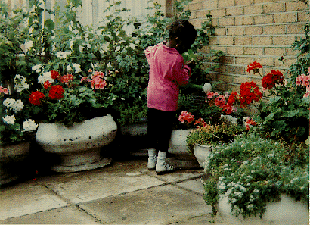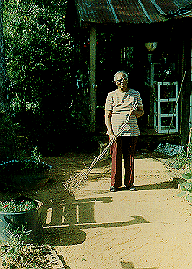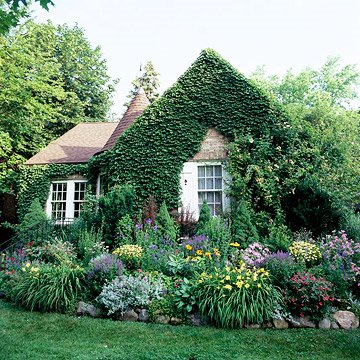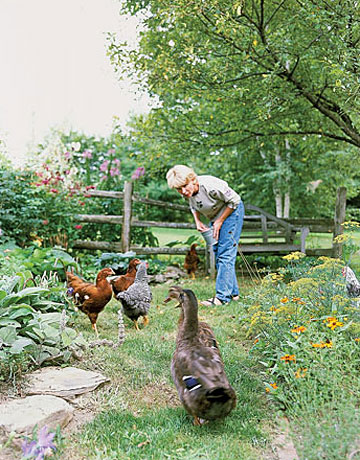Cottage Gardens and Swept Yards: Recreating a Vernacular Horticulture
admin January 3rd, 2011
This is one of my favorite posts I’ve ever written - it appeared last year at Science Blogs, and I find myself drawn back, as I plan my garden to the question of what constitutes a true vernacular garden for my place.
At first glance, swept yards, derived from Africa, at one time common in the south and now mostly the province of a few, aging African-American southerners; and Cottage Gardens, invented in Britain under the feudal system and now evolved into a trendy “flower garden style” that implies mostly a mix of abundant plants and mulched paths as seen in any supermarket magazine, have nothing to do with one another.

But looking past the obvious, the two of them have a great deal in common indeed. Both emerged from the need to make good use of a smaller piece of land for a family with subsistence needs. Both responded to climate and culture and evolved over time in keeping with their environment and the needs of the people that grew them. Both allowed for a substantial variety of activities and plant life in a small space. Both made use of what was available, valuable and abundant, rather than focusing on rarities. Both responded to inadequate housing by transforming outdoor spaces into living spaces. And perhaps most importantly, both took pragmatic traditions and made them respond to two equally important needs - the need for food and medicine and subsistence from one’s garden, but also the need for beauty, peace, and respite and a place to express one’s artfulness.
In his superb history _African-American Gardens and Yards in the Rural South_, Richard Westmacott tracks the origin of the swept yard back to West Africa, and explores how it changed over centuries, from slave yard to a now-dying way of life in the rural south. Instead of attempting to grow grass or other ground covers in the hot south, often on difficult red clay, rural southerners would sweep and tamp down that clay until it baked hard as a rock, reducing dust tracking and making the space suitable for yard work. Houses, hot during the day, were abandoned and people moved outside to shaded yards where they could do the washing, cook, eat, butcher animals, and do other heavy work in the shade of trees. The gardens, a separate but often connected space, contain the crops - and the pig area, the chickens and other livestock. The yard was separate from the garden, often marked by an enclosure, and as Westmacott observed had originally been marked by medicinal herbs and dooryard plants, but gradually transitioned to largely ornamental flowers. Westmacott observes of the sustainability of the whole of traditional southern rural yards and gardens:
“It might be argued that a vernaculture garden must also be sustainable. Gardening is an adaptation of nature, and for gardening to become indigenous to an society, it must be sustainable. In most African societies, sustainability is intricately associated with religious beliefs. As has been shown, most of the gardeners in this study expressed alarm at the changes they saw occurring in the environment, and many lifestyles were remarkably self-sufficient and sustainable.”

A yard swept bare of plant life may not sound very pretty, but in reality, it made wise use of what there was - it allowed housekeepers to manage the clay and dirt, while transforming the dooryard into the “outdoor rooms” that ornamental garden books like to praise but rarely actually succeed in creating. And it wasn’t an empty space - containers and marginal areas were planted with trees and shrubs, where water could be focused. Recycled materials and scavenged ones made a remarkably creative yard full of planters made from abandoned materials - themselves artful. Moreover, there is, in the photos in Westmacott, a seamlessness to the transition space between yard, garden, livestock and field. Indeed, although I refer to this as an African-American tradition, it was so successful that before the advent of warm weather grasses, the swept yard was the norm in much of the rural south in white and black households, regardless of class.
I recently emailed Aaron Newton, my co-author on _A Nation of Farmers_ and my guide through southern life. We’ve been working together for four years now, and over the years have spent a lot of time politely and not so politely explaining the realities of our respective regions to one another, so I wasn’t surprised that my query about whether anyone still swept their yard in his region of North Carolina was responded to by “Does anyone still wear tricornered hats up by you?” I took that to be a no - it is, as Westmacott documents, a dying tradition - supplanted by warm weather landscape grasses, by people spending more time in air conditioning and less in their yards, but the homogenization of garden design and by the destructions of the informal economy and subsistence activities. But a lower energy, less wealthy society may yet find uses for some of the things that the swept yard did well.
Most interesting to me about the swept yard is how it contained space for both ornamental and food gardening. Westmacott observes that traditional African-American yards were often a riot of flowers and plants - but not organized as most white gardens were. First of all, the emphasis was on vigorous and abundant production and self-seeders. Flowering plants, instead of being organized by color and form were interspersed with one another, with a preference for bright colors. Until recently, few shrubs were involved - because of the high cost of woody plants, most woodies were food producers, rather than purely ornamental. Medicinal herbs would have been mixed in with flowers grown for scent and beauty. Because of the high cost of plants, annuals and seed grown plants were preferred and were shared widely. In this sense, the vernacular traditions of the rural south sound very much like the cottage garden.
In the early 1950s, Eudora Welty introduced the writer Elizabeth Lawrence to market bulletins published throughout Mississippi where gardeners sold perennials, herbs and ornamental sto one another. Lawrence took up a correspondence with dozens of women and men (mostly women) who divided and shared seeds and plants for a small fee, and generously offered advice and told stories of their origins. In their gardens were plants that were otherwise lost to the seed trade, being spread about and preserved in household gardens, and shared for pennies among men and women who valued them for the art and expression they could create. In _Gardening for Love_ Lawrence observes that these gardeners were minimally compensated for the considerable time and effort they spent in preparing and shiping plants, and explaining how to grow them - and most of them worked long hours doing other work. The compensation was the spread, the abundance, the increase in beauty and the preservation of the plants.
In contrast to the swept yard, at least superficially, the cottage garden is booming. Googling “cottage garden” got me a bazillion entries. The problem is that all of them are a watered down version of the cottage garden - but very few of them have anything to do with the cottage garden as it existed before it was taken over by the affluent who had no reason to grow anything but flowers. I have a fondness for Gertrude Jekyll too, but for those of us interested in vernacular gardens, she did everyone a disservice by taking up the cottage garden. Yes, they are very beautiful - but their beauty in reality lay in the way they combined aesthetics and subsistence - and the subsistence has been erased.

But the history of the cottage garden has as much to do with bees and pigs and vegetables as it does with wisteria and foxgloves. The recasting of cottage gardens as an intentionally informal style to be propagated by comparatively affluent ornamental gardeners obscures the fact that the cottage garden grew up among people just as poor as many of the rural African-Americans who preserved the swept yard.
Christopher Lloyd’s and Richard Bird’s _The Cottage Garden_ offers a concise history and at least an attempt to draw us back to the mixed use garden with a heavy emphasis on food plants and herbs. He observes that John Claudius Loudon in the 18th century attempted to help cottagers with reduced land access (as a result of the destructive enclosure laws) to use cottage style gardening to be able to feed a famly of five on 600 square yards of garden. Pigs, chickens and bees were essential to this project. They track back the ornamental elements of the kitchen garden to the Elizabethan dooryard and the herbs that lived in it. As in the African-American yards in the South, at first medicinal and other functional herbs predominated but they too had ornamental value, and it was hard to tell if tall spires of hollyhock were central because of their medicinal or ornamental utility.

The presumptions of the cottage garden were much the same as the African-American yard despite the radical difference in climate and culture - that much had to be gotten out of small space, that one needed a place to live and work outside when the weather permitted, that the ornament and utility were not incompatible, and that the best plants were abundant self-seeders or easily grown annuals. It had the additional virtue of using vertical space well - which some African-American gardens had as well, particularly in the use of scavenged articles as trellises. The ubiquitous cottage garden image, of course, is of a cottage covered with ivy or wisteria.
As the cottage garden was adopted by more affluent people, and transferred away from the real cottages of low income farmers and workers in Britain, the cottage garden changed, and became what we see today - a garden style, more heavily invested in perennials, with more shrubs and almost no emphasis on plant utility. The romanticization of the cottage in both gardens and literature worked to the detriment of the actual cottager - now that people longed to live in them, admired them, they became harder to actually live in for most working people. In _Sense and Sensibility_ Jane Austen’s romantic Willoughby jesting threatens to tear down his estate and replace it with a cottage. But the cottage imagined in the romantic imagination was erased of subsistence functions, because, they were unromantic. In Georgette Heyer’s superb _A Civil Contract_ the overly romantic, affluent Julia declares she would be delighted to live in a cottage, but her mother clarifies (in a terrifically funny passage) this fantasy for what it is - a sanitized dream.
“Could you be happy in a cottage? I could! How often I have longed to live in one - with white walls and a thatcheed roof and a neat little garden! We’ll have a cow and I’ll learn to milk and make butter and cheese. And some hens and a bee-hive, and some pigs.”
”Oh, won’t you?” struck in her unappreciative brother. Well, if you mean to cook the meals, Lynton will precious soon want something more and who is to kill the pigs and muck out the henhouse?”
…”Lady Oversly, having removed Julia’s hat, had clasped her in her arms and was tenderly wiping the tears from her face, but she looked up at this and expalined: “Live in a cottage? Oh, no, dearest you would be very ill-advicsed to do that! Particularly a thatched one, for I believe that thatch harbors rats, though nothing, of course, is more picturesque, and I perfectly understand why you should have a fancy for it! But you would find it sadly uncomfortable: it wouldn’t do for you at all, or for Adam either, I daresay, since you have both of you been accustomed to live in a very different style.
And as for hens, I would not on any account rear such dispiriting birds! You know how it is whenever an extra number of eggs is needed in the kitchen: the hen woman is never able to supply them and always says it is because the creatures are broody. Yes, and they make sad noises which you, my love, with your exquisite sensibility would find quite insupportable. And pigs,” concluded her ladyship with a shudder, “have a most unpleasant odour!”
The beauty of the cottage garden in many ways was its success, and thus its downfall - while beauty was always part of the project of creating the garden, always intertwined with utility, its very success at being lovely made it ripe for the erasure of its utility. But it is possible to come back to the cottage garden - to the yard as proximate space that extends the kitchen and the household outwards, brings us outside and into a riot of color and forms that are both beautiful and useful. There is still a place for the herb garden, and the cottage garden and the traditional African-American yard remind us to value plants that may be both ornamental and useful, that are vigorous and energetic.
The swept yard and other southern vernacular garden elements don’t much suit my climate, but for thousands of my readers, they could be useful. This publication by cooperative extension suggests strategies for implementing some of the traditional design elements of African-American yards
In my wet climate, the cottage garden model makes a lot of sense. I may have 27 acres, but I also have a yard - a space outside my kitchen door that I have gradually been converting to herbs, flowers, vegetables and fruiting trees. Looking at the cottage garden model, I can think of ways of better integrating aesthetics and practicality.
The reality is that a shift to subsistence in a densely populated world will require us to draw upon all of the things we have learned about how to meet our needs - for food and beauty - in smaller spaces. There are thousands of traditions to draw upon from all over the world, and all of them will have things we can take and make use of. As we cast back upon our collective history, the answers to how we will feed ourselves - and feed our souls - is contained in part in stories from our past.